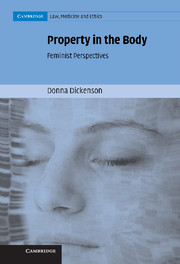Book contents
- Frontmatter
- Contents
- Acknowledgements
- Preface
- 1 Do We All Have ‘Feminised’ Bodies Now?
- 2 Property, Objectification and Commodification
- 3 The Lady Vanishes: What's Missing from the Stem Cell Debate
- 4 Umbilical Cord Blood Banks: Seizing Surplus Value
- 5 The Gender Politics of Genetic Patenting
- 6 Biobanks: Consent, Commercialisation and Charitable Trusts
- 7 The New French Resistance: Commodification Rejected?
- 8 Tonga, the Genetic Commons and No Man's Land
- 9 Afterword
- Bibliography
- Index
9 - Afterword
Published online by Cambridge University Press: 15 December 2009
- Frontmatter
- Contents
- Acknowledgements
- Preface
- 1 Do We All Have ‘Feminised’ Bodies Now?
- 2 Property, Objectification and Commodification
- 3 The Lady Vanishes: What's Missing from the Stem Cell Debate
- 4 Umbilical Cord Blood Banks: Seizing Surplus Value
- 5 The Gender Politics of Genetic Patenting
- 6 Biobanks: Consent, Commercialisation and Charitable Trusts
- 7 The New French Resistance: Commodification Rejected?
- 8 Tonga, the Genetic Commons and No Man's Land
- 9 Afterword
- Bibliography
- Index
Summary
For if the body is a thing among things, it is so in a stronger and deeper sense than they.
The strangeness of the world itself … is in one way or another always presented to us through the strangeness of the flesh.
I have argued throughout this book that much disquiet at the new biotechnological enclosures of the body derives from the fear that bodies are being objectified, commodified, and thus also feminised. In the last chapter I also suggested some deficiencies in the enclosure metaphor itself. Here is another one: the body is not a thing like land, even though land is not merely a thing either, particularly not to indigenous peoples such as the Maori. Land carries with it a set of connotations, rules and affections, none of which typify an object of ownership, if ownership is primarily conceived as the right to do whatever one wants with one's possessions. Particularly because indigenous peoples were themselves treated as something less than full subjects by their colonisers, colonised peoples rarely view their land merely as a thing among things, or as the terra nullius of the occupying power.
True, I have drawn a parallel between terra nullius and res nullius. Yet the body is still not an object in the same way that land is an object, because we are embodied subjects, not ‘enlanded’ subjects. Consciousness itself is embodied, as Merleau-Ponty argues, and the body the primary locus of intentionality.
- Type
- Chapter
- Information
- Property in the BodyFeminist Perspectives, pp. 179 - 181Publisher: Cambridge University PressPrint publication year: 2007



